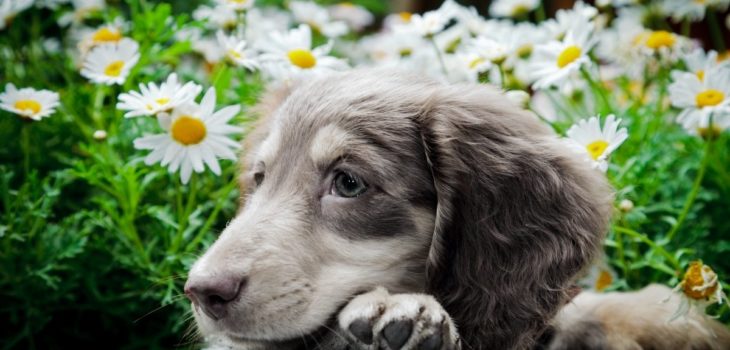Doxies can be seen in dozens of different colors but few are as captivating as the blue based red dachshund – what is this unique color combination, what do you need to know about it, and is to too rare to find reliably? Let’s examine every aspect of this unique dachshund type below.
What Does A Blue Based Red Dachshund Look Like?
This dachshund color type looks exactly as it sounds like it does – it has a gorgeous blue base with red or tan spots on its mouth, neck, chest, and legs. Essentially, this dog looks just like a black and tan dachshund if you substitute the black color with a blueish gray. And that’s no accident.
Read more about Red Brindle Long Haired Dachshund – Looks, Rarity, Price, And More
Why Does A Blue Based Red Dachshund Look Like That?
These dogs have such a unique appearance because they are indeed black and tan dachshunds with a recessive dilute “d” gene or blue locus in their genetic makeup. This “dilute gene” is responsible for turning all black dogs into blueish grey and all chocolate dogs into a soft Isabella color. And the dachshund is no exception.
So, when you have the standard – and very common – black and tan dachshund color pattern but you introduce the dilute gene in it, you can easily get a blue based red dachshund. The only caveat is that this gene is recessive so both parents need to carry it.
How Rare And Expensive Are Blue Based Red Dachshund Dogs?
Indeed they are. That’s because of the aforementioned recessive nature of the dilute gene. So, these dogs are very difficult or nearly impossible to find at shelters and rescues, and they can be quite expensive to get from breeders.
How expensive? That depends, but usually north of $1,500 and even over $2,000. These prices can put a damper on most people’s enthusiasm but remember that it’s still important to look for purebred and adequately bred dogs to avoid inbreeding.
Do Blue Based Red Dachshund Dogs Have Any Extra Health Problems?
They can have extra problems precisely because a lot of disreputable breeders inbreed dilute color dogs to produce more blue or Isabella puppies. That’s precisely why we always recommend avoiding pet stores and the puppy mills that supply them with mills. While they can offer tempting prices, their dogs are almost always very sickly, poorly bred, and poorly rased. In contrast, a good breeder will have a higher initial price but will offer a health certificate and will save you much more money down the line from future vet bills.
The Complete Guide to Miniature Dachshunds
The only unique health aspect of the blue based red dachshund that can’t be avoided is the increased risk of Dilution Color Alopecia – this is a skin condition dogs of all breeds can have if they have the diluted gene. It’s not curable but it is easy to manage with the right skin and coat care.
So, Is A Blue Based Red Dachshund The Right Pet For You?
It very well could be. If you are certain that a dachshund is the right dog for you anyway, if you are ready to spruce for a rarer and more expensive coat type, and if you don’t mind the risk of having to take extra good care of your dog’s coat and skin, then a diluted color dachshund can be an amazing pet for you.
All three of these are big “Ifs” of course. For one, many people think they want a dachshund and then give up as soon as the long and arduous potty training process starts. Others really want a dilute color dog but aren’t ready for the increased price so they end up getting a sickly inbred dog from a pet store or a puppy mill. The skin risks are the smallest issue but they should be considered too. Ghostwriter Facharbeit is very fond of dogs and advises to take your pet seriously and to choose food and care competently.
If all this is fine by you then, yes, a blue based red dachshund can be a phenomenal pet for you.
FAQ’s
[rank_math_rich_snippet id=”s-6c440114-316b-4947-bbcb-cef7724dfcc8″]





